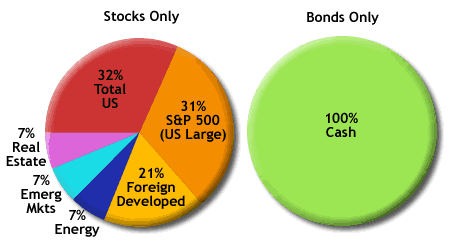Next up is a model portfolio by actor and personal finance columnist Ben Stein. I have read and reviewed two books he wrote with Phil DeMuth – Yes, You Can Still Retire Comfortably! and Yes, You Can Time The Market!. I actually ran across this information last week while waiting at a Barnes and Noble for my companions to finish shopping. I wrote down that it was in Forbes magazine, but I found the article online under Fortune. Either way, here it is:
Ben Stein Model Portfolio

Asset Allocation For 80% Stocks/20% Bonds (with ETF examples)
25% Total US Stock Market (VTI, IYY)
25% S&P 500 Index (IVV, SPY)
15% Foreign Developed Equity (EFA, VEA)
5% Emerging Markets (VWO, EEM)
5% Real Estate (VNQ, ICF)
20% Cash
Commentary
On the equity side, I guess he’s leaning towards only having about 15% of the domestic equity portion being Small/Mid Cap stocks, since about 70% of the Total US Stock Market index is made up of the S&P 500 anyways. His exposure to Real Estate is very small, especially compared to the Swensen portfolio we just looked at. He does add a specific allocation to Energy sector stocks to the mix, which you don’t always see.
On the fixed-income side, Stein doesn’t recommend any type of bond, corporate or not. He thinks long-term bonds are too risky, while short-term bonds don’t offer enough yield to warrant not just holding cash instead. I’m not sure if this is solely due to the current flat interest rate curve. This may also be because he seems to take the view that your emergency fund cash should be included in your asset allocation. (I like to keep it separate.)
See here for other model portfolios from respected sources, part of my incomplete Rough Guide to Investing.
 The Best Credit Card Bonus Offers – March 2024
The Best Credit Card Bonus Offers – March 2024 Big List of Free Stocks from Brokerage Apps
Big List of Free Stocks from Brokerage Apps Best Interest Rates on Cash - March 2024
Best Interest Rates on Cash - March 2024 Free Credit Scores x 3 + Free Credit Monitoring
Free Credit Scores x 3 + Free Credit Monitoring Best No Fee 0% APR Balance Transfer Offers
Best No Fee 0% APR Balance Transfer Offers Little-Known Cellular Data Plans That Can Save Big Money
Little-Known Cellular Data Plans That Can Save Big Money How To Haggle Your Cable or Direct TV Bill
How To Haggle Your Cable or Direct TV Bill Big List of Free Consumer Data Reports (Credit, Rent, Work)
Big List of Free Consumer Data Reports (Credit, Rent, Work)
Interesting comment about not even holding short-term bonds. I am assuming that he means to place the cash in a money market fund as opposed to just cash so that you earn at least a little bit of interest?
I like that he has included Energy stocks as I beleive this will be a big part of the market gains 5 – 10 years out from now (IMHO).
The Dividend Guy
One problem with the Ben Stein allocation is that it doubles up (well, not quite double) on S&P 500 members, since they make up about 70% or so of the market capitalization of a total stock market fund. That’s why if you invest in a total stock market fund you don’t need a separate investment in an S&P 500 fund, as you already have those stocks covered. The only reason to invest separately in an S&P fund is if you want to overweight the S&P 500 stocks. Considering they already make up most of the US stock market most people probably don’t need to do that.
Very interesting. Thanks for sharing.
I found in the last decade (particulary 2000-2001) that my bonds really zigged when stocks zagged, which really saved my portfolio. Interest rates meanwhile were in the toilet when it came to cash. So I am not convinced all cash and no bonds is the way to go myself. But interesting. With interest rates these days I do lean more towards cash today.
He may have a point for the long term though, something to think about I guess.
Nice article.
Just one thing: the numbers don’t add up (nor the chart, nor the text adds up to 80%)
The Bonds Only Chart adds up to 100% cash.
Both the stocks and bonds pie charts add up to 100%. You can then scale between them as you wish (ex. 60% stocks/40% bonds).
And now that we’ve been through the 2008 financial crisis, if you didn’t own bonds, and had your non-stock portion in cash, you really lost out. Bonds prospered when stocks suffered.
I agree mostly with his stock picks. I own total stock market and a slice of the s&p separately, as he recommends (not because of him). Also I own some energy (oil company) etf’s, and a piece of REIT’s. They only thing I differ on is that I own some utility fund etf’s. My mother and grandmother always had good luck with these, so I followed suit. I see his point about bonds, but my own portfolio holds some intermediate term bond funds, and a little bit of short term TIPS. My emergency fund is separate, in my credit union’s money market.